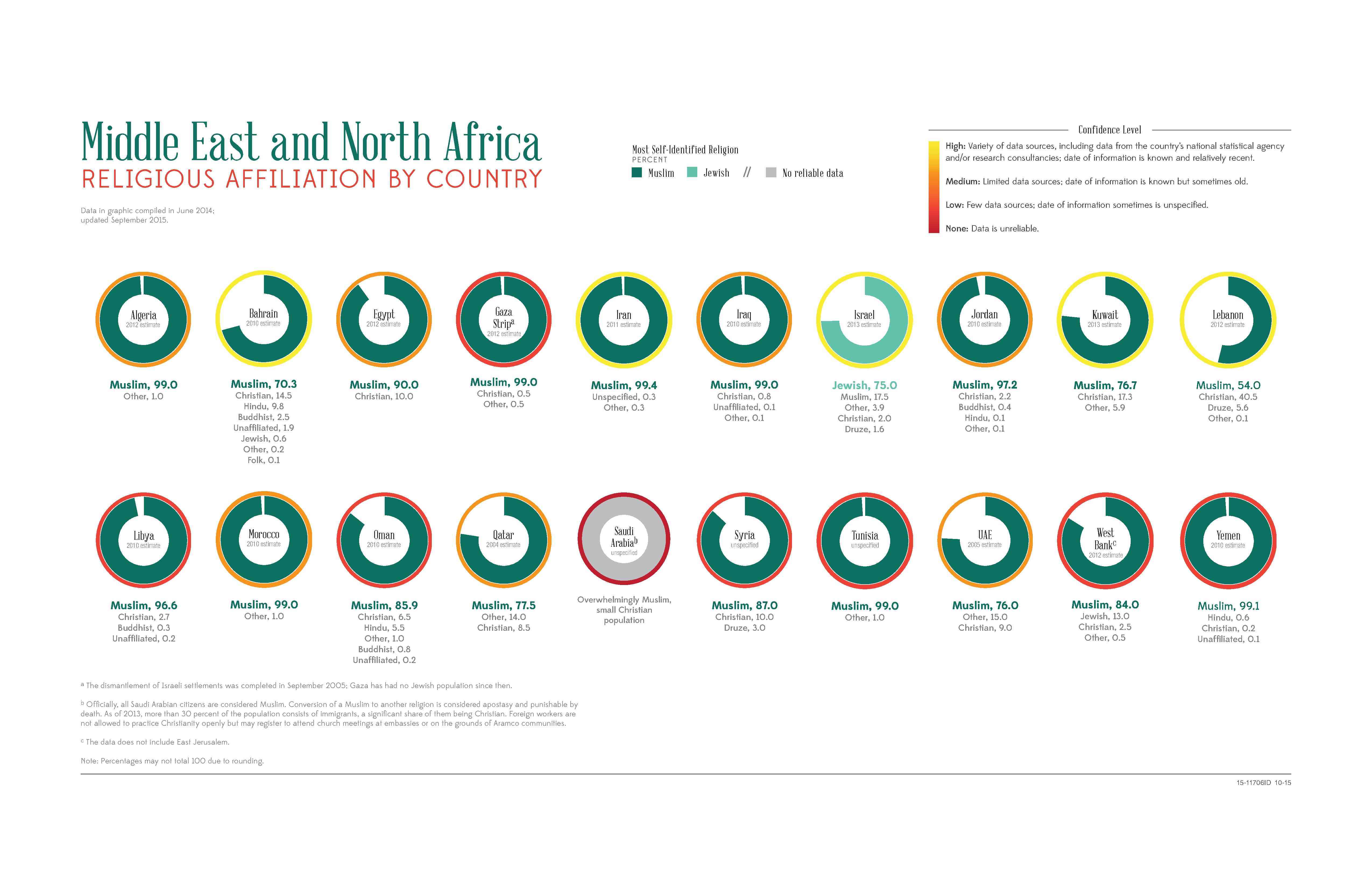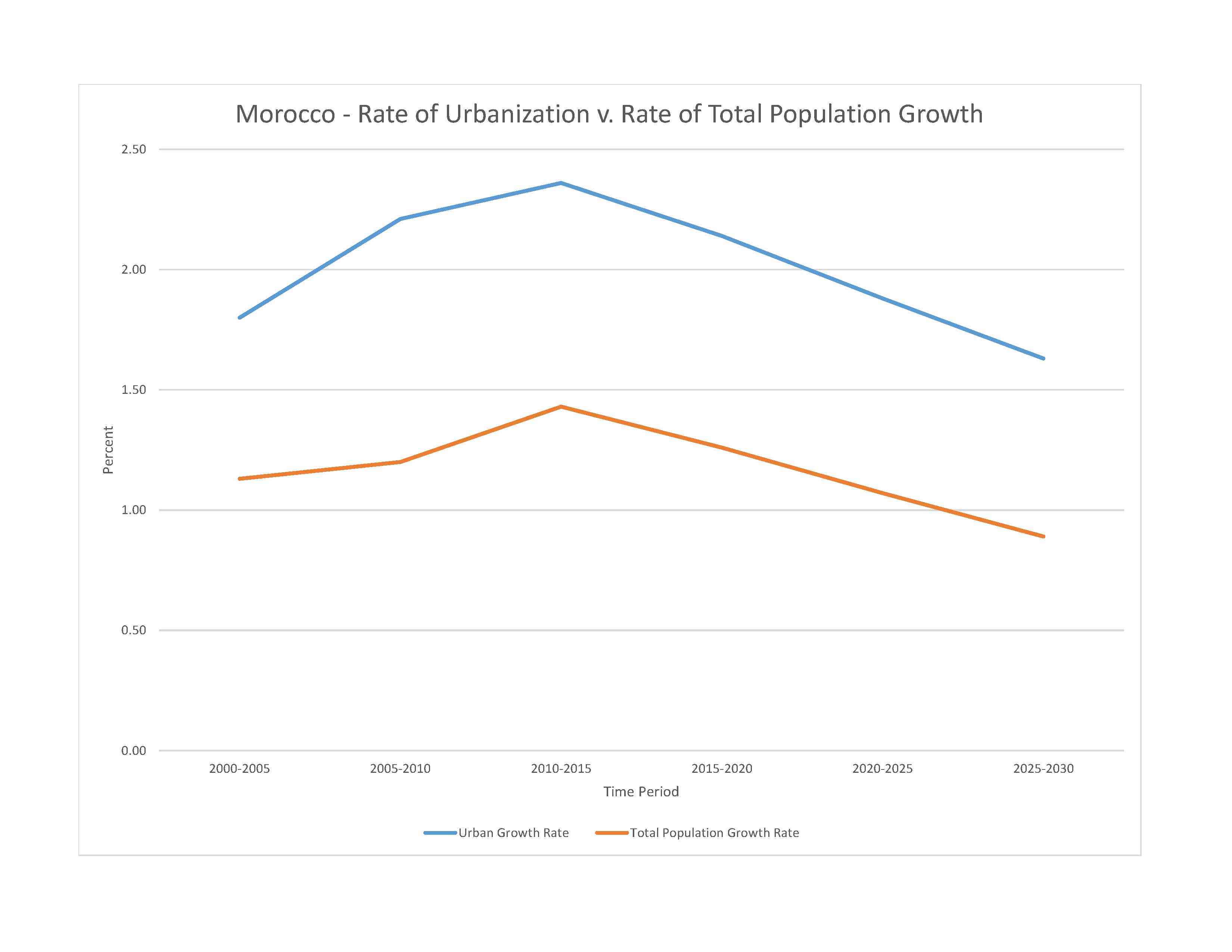
37,067,420 (2023 est.)
note: includes Western Sahara
noun: Moroccan(s)
adjective: Moroccan
Arab-Amazigh 99%, other 1%
note: does not include data from the former Western Sahara
Arabic (official), Tamazight languages (Tamazight (official), Tachelhit, Tarifit), French (often the language of business, government, and diplomacy); note - the proportion of Tamazight speakers is disputed
major-language sample(s):
كتاب ديال لحقائق متاع العالم، احسن مصدر متاع المعلومات الأساسية (Arabic)
The World Factbook, the indispensable source for basic information.
Arabic audio sample:
Muslim 99% (official; virtually all Sunni,
note: does not include data from the former Western Sahara

Morocco is undergoing a demographic transition. Its population is growing but at a declining rate, as people live longer and women have fewer children. Infant, child, and maternal mortality rates have been reduced through better health care, nutrition, hygiene, and vaccination coverage, although disparities between urban and rural and rich and poor households persist. Morocco’s shrinking child cohort reflects the decline of its total fertility rate from 5 in mid-1980s to 2.2 in 2010, which is a result of increased female educational attainment, higher contraceptive use, delayed marriage, and the desire for smaller families. Young adults (persons aged 15-29) make up almost 26% of the total population and represent a potential economic asset if they can be gainfully employed. Currently, however, many youths are unemployed because Morocco’s job creation rate has not kept pace with the growth of its working-age population. Most youths who have jobs work in the informal sector with little security or benefits.
During the second half of the 20th century, Morocco became one of the world’s top emigration countries, creating large, widely dispersed migrant communities in Western Europe. The Moroccan Government has encouraged emigration since its independence in 1956, both to secure remittances for funding national development and as an outlet to prevent unrest in rebellious (often Berber) areas. Although Moroccan labor migrants earlier targeted Algeria and France, the flood of Moroccan "guest workers" from the mid-1960s to the early 1970s spread widely across northwestern Europe to fill unskilled jobs in the booming manufacturing, mining, construction, and agriculture industries. Host societies and most Moroccan migrants expected this migration to be temporary, but deteriorating economic conditions in Morocco related to the 1973 oil crisis and tighter European immigration policies resulted in these stays becoming permanent.
A wave of family migration followed in the 1970s and 1980s, with a growing number of second generation Moroccans opting to become naturalized citizens of their host countries. Spain and Italy emerged as new destination countries in the mid-1980s, but their introduction of visa restrictions in the early 1990s pushed Moroccans increasingly to migrate either legally by marrying Moroccans already in Europe or illegally to work in the underground economy. Women began to make up a growing share of these labor migrants. At the same time, some higher-skilled Moroccans went to the US and Quebec, Canada.
In the mid-1990s, Morocco developed into a transit country for asylum seekers from Sub-Saharan Africa and illegal labor migrants from Sub-Saharan Africa and South Asia trying to reach Europe via southern Spain, Spain’s Canary Islands, or Spain’s North African enclaves, Ceuta and Melilla. Forcible expulsions by Moroccan and Spanish security forces have not deterred these illegal migrants or calmed Europe’s security concerns. Rabat remains unlikely to adopt an EU agreement to take back third-country nationals who have entered the EU illegally via Morocco. Thousands of other illegal migrants have chosen to stay in Morocco until they earn enough money for further travel or permanently as a "second-best" option. The launching of a regularization program in 2014 legalized the status of some migrants and granted them equal access to education, health care, and work, but xenophobia and racism remain obstacles.
0-14 years: 26.01% (male 4,919,266/female 4,722,463)
15-64 years: 65.92% (male 12,124,939/female 12,311,552)
65 years and over: 8.06% (2023 est.) (male 1,455,355/female 1,533,845)
note: does not include data from the former Western Sahara
total dependency ratio: 52.2
youth dependency ratio: 40.9
elderly dependency ratio: 11.3
potential support ratio: 8.9 (2021 est.)
note: does not include data from the former Western Sahara
total: 30.2 years (2023 est.)
male: 29.8 years
female: 30.7 years
note: does not include data from the former Western Sahara
0.88% (2023 est.)
note: does not include data from the former Western Sahara
17.1 births/1,000 population (2023 est.)
note: does not include data from the former Western Sahara
6.6 deaths/1,000 population (2023 est.)
note: does not include data from the former Western Sahara
-1.7 migrant(s)/1,000 population (2023 est.)
note: does not include data from the former Western Sahara
the highest population density is found along the Atlantic and Mediterranean coasts; a number of densely populated agglomerations are found scattered through the Atlas Mountains as shown in this 
urban population: 65.1% of total population (2023)
rate of urbanization: 1.88% annual rate of change (2020-25 est.)
note: data does not include former Western Sahara

3.893 million Casablanca, 1.959 million RABAT (capital), 1.290 million Fes, 1.314 million Tangier, 1.050 million Marrakech, 979,000 Agadir (2023)
at birth: 1.05 male(s)/female
0-14 years: 1.04 male(s)/female
15-64 years: 0.98 male(s)/female
65 years and over: 0.95 male(s)/female
total population: 1 male(s)/female (2023 est.)
note: does not include data from the former Western Sahara
72 deaths/100,000 live births (2020 est.)
note: does not include data from the former Western Sahara
total: 18.7 deaths/1,000 live births (2023 est.)
male: 20.9 deaths/1,000 live births
female: 16.4 deaths/1,000 live births
note: does not include data from the former Western Sahara
total population: 74 years (2023 est.)
male: 72.3 years
female: 75.7 years
note: does not include data from the former Western Sahara
2.27 children born/woman (2023 est.)
note: does not include data from the former Western Sahara
1.11 (2023 est.)
70.8% (2018)
note: does not include data from the former Western Sahara
improved: urban: 98.3% of population
rural: 79.1% of population
total: 91% of population
unimproved: urban: 1.7% of population
rural: 20.9% of population
total: 9% of population (2017 est.)
note: does not include data from the former Western Sahara
6% of GDP (2020)
note: does not include data from the former Western Sahara
0.73 physicians/1,000 population (2017)
note: does not include data from the former Western Sahara
1 beds/1,000 population (2017)
note: does not include data from the former Western Sahara
improved: urban: 98.2% of population
rural: 72.4% of population
total: 88.8% of population
unimproved: urban: 1.8% of population
rural: 27.6% of population
total: 11.2% of population (2020 est.)
note: does not include data from the former Western Sahara
26.1% (2016)
note: does not include data from the former Western Sahara
total: 0.51 liters of pure alcohol (2019 est.)
beer: 0.18 liters of pure alcohol (2019 est.)
wine: 0.24 liters of pure alcohol (2019 est.)
spirits: 0.09 liters of pure alcohol (2019 est.)
other alcohols: 0 liters of pure alcohol (2019 est.)
total: 14.5% (2020 est.)
male: 28.2% (2020 est.)
female: 0.8% (2020 est.)
2.8% (2019/20)
note: does not include data from the former Western Sahara
58.8% (2023 est.)
women married by age 15: 0.5%
women married by age 18: 13.7% (2018 est.)
6.8% of GDP (2020)
note: does not include data from the former Western Sahara
definition: age 15 and over can read and write
total population: 75.9%
male: 84.8%
female: 67.4% (2021)
note: does not include data from the former Western Sahara
total: 14 years
male: 14 years
female: 14 years (2021)
note: does not include data from the former Western Sahara
NOTE: The information regarding Morocco on this page is re-published from the 2024 World Fact Book of the United States Central Intelligence Agency and other sources. No claims are made regarding the accuracy of Morocco 2024 information contained here. All suggestions for corrections of any errors about Morocco 2024 should be addressed to the CIA or the source cited on each page.
This page was last modified 04 May 24, Copyright © 2024 ITA all rights reserved.